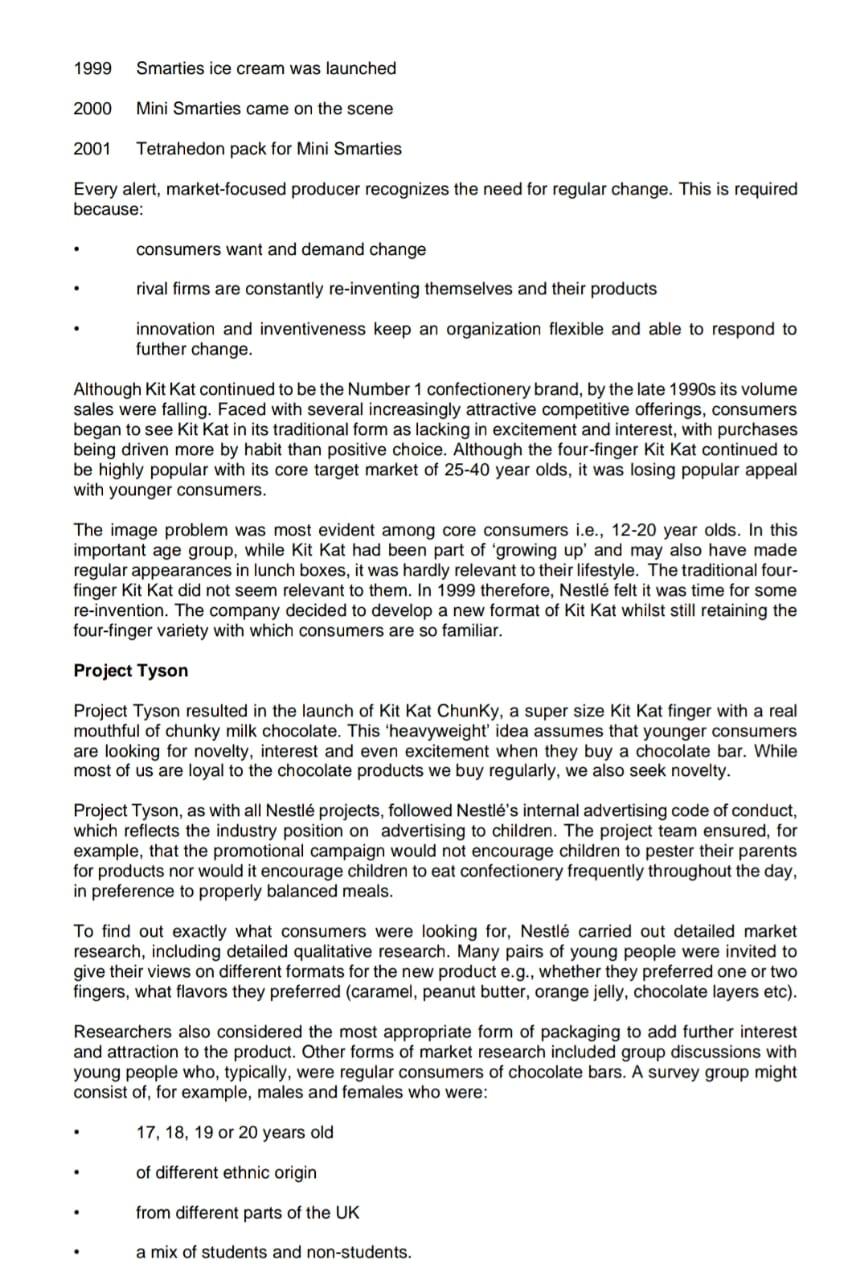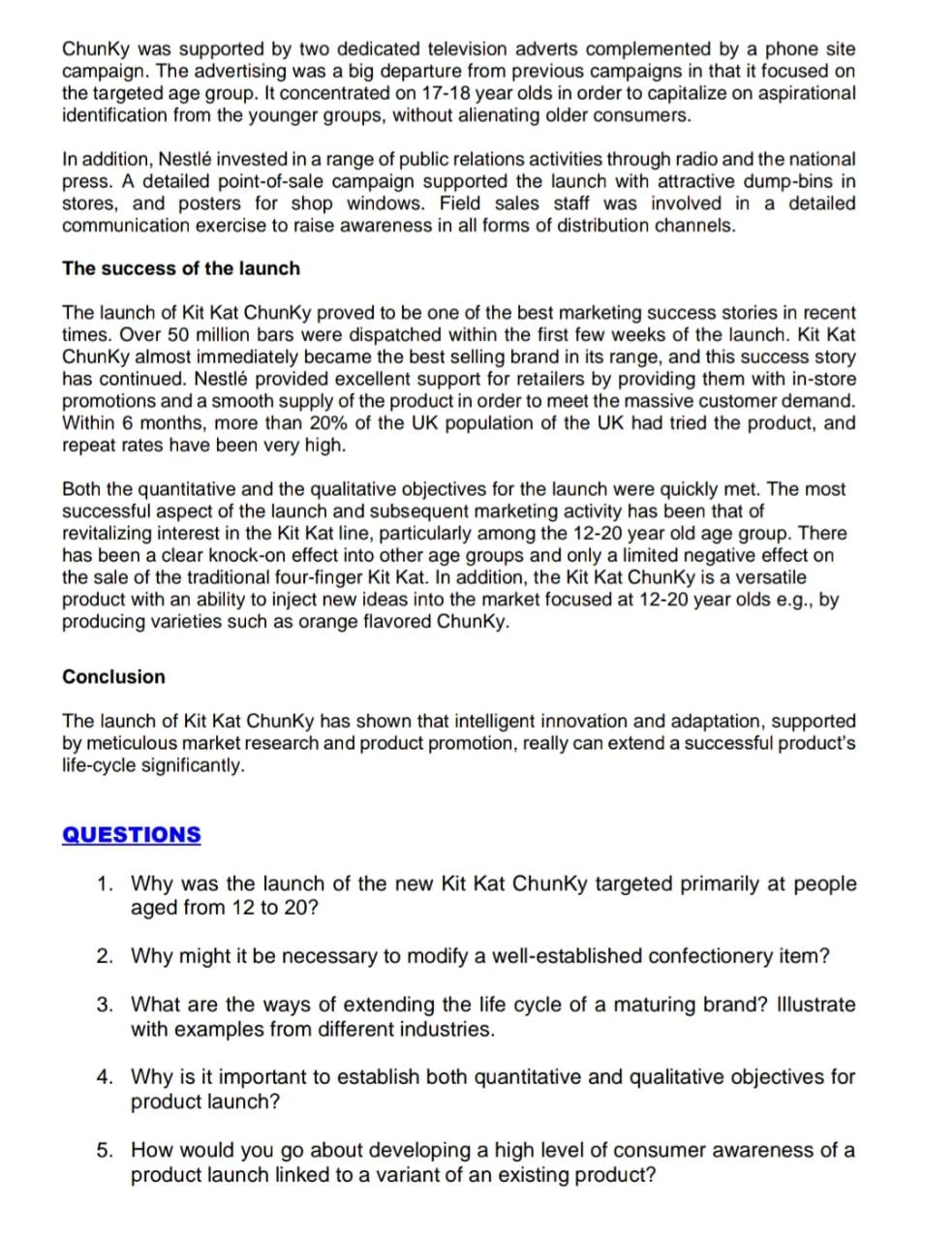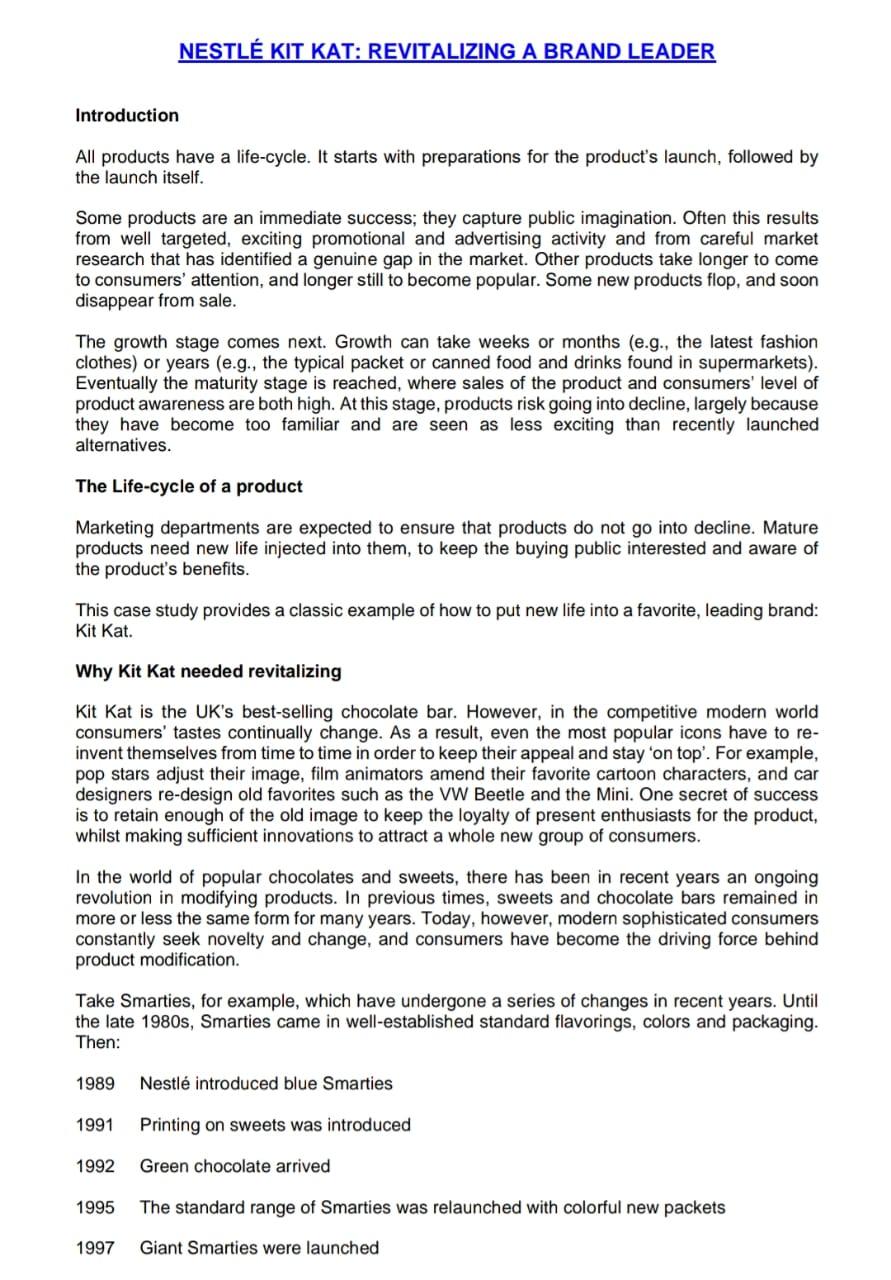



1999 Smarties ice cream was launched 2000 Mini Smarties came on the scene 2001 Tetrahedon pack for Mini Smarties Every alert, market-focused producer recognizes the need for regular change. This is required because: - consumers want and demand change - rival firms are constantly re-inventing themselves and their products - innovation and inventiveness keep an organization flexible and able to respond to further change. Although Kit Kat continued to be the Number 1 confectionery brand, by the late 1990 s its volume sales were falling. Faced with several increasingly attractive competitive offerings, consumers began to see Kit Kat in its traditional form as lacking in excitement and interest, with purchases being driven more by habit than positive choice. Although the four-finger Kit Kat continued to be highly popular with its core target market of 2540 year olds, it was losing popular appeal with younger consumers. The image problem was most evident among core consumers i.e., 12-20 year olds. In this important age group, while Kit Kat had been part of 'growing up' and may also have made regular appearances in lunch boxes, it was hardly relevant to their lifestyle. The traditional fourfinger Kit Kat did not seem relevant to them. In 1999 therefore, Nestl felt it was time for some re-invention. The company decided to develop a new format of Kit Kat whilst still retaining the four-finger variety with which consumers are so familiar. Project Tyson Project Tyson resulted in the launch of Kit Kat ChunKy, a super size Kit Kat finger with a real mouthful of chunky milk chocolate. This 'heavyweight' idea assumes that younger consumers are looking for novelty, interest and even excitement when they buy a chocolate bar. While most of us are loyal to the chocolate products we buy regularly, we also seek novelty. Project Tyson, as with all Nestl projects, followed Nestl's internal advertising code of conduct, which reflects the industry position on advertising to children. The project team ensured, for example, that the promotional campaign would not encourage children to pester their parents for products nor would it encourage children to eat confectionery frequently throughout the day, in preference to properly balanced meals. To find out exactly what consumers were looking for, Nestl carried out detailed market research, including detailed qualitative research. Many pairs of young people were invited to give their views on different formats for the new product e.g., whether they preferred one or two fingers, what flavors they preferred (caramel, peanut butter, orange jelly, chocolate layers etc). Researchers also considered the most appropriate form of packaging to add further interest and attraction to the product. Other forms of market research included group discussions with young people who, typically, were regular consumers of chocolate bars. A survey group might consist of, for example, males and females who were: - 17,18,19 or 20 years old - of different ethnic origin - from different parts of the UK Using focus groups in this way, researchers were able to compile data on the views and feelings of representative samples of the targeted groups of consumers. The research provided clear evidence that: the targeted population of 12-20 year olds were attracted to the idea of the single Chunky finger - Project Tyson could be a winner. The research also identified the type of packaging with the greatest appeal - a mainly red and silver flow wrap. It also became clear that Kit Kat ChunKy would inject new interest in Kit Kat across a broad range of consumers, including young children and older adults. The research examined different types of wrappings and formats. In particular, it compared twofinger and single-finger variants of Kit Kat ChunKy. The single-finger proved to be most popular with the 12-20 year old group, and was also the most distinctive form that the new product could take. The research also indicated that a twofinger variety would, in some ways, compete with the four-finger variety. This would lead to Kit Kat competing against itself; not a very good idea! By contrast, the single-finger Kit Kat ChunKy provided a promising line extension. Objectives for the launch A wise company will look to justify every new venture in strict business terms: it will set tough performance targets. These in turn can be converted into production targets, cost estimates and revenue projections. Quantitative objectives Nestl set demanding quantitative objectives for the launch. Nestl aimed to: - achieve 90% distribution in all sectors of the confectionery market within the first four weeks after the launch - sell 50 million units (i.e., 2,750 tons of product) in 1999, the year of the launch - increase sales in subsequent years. Qualitative objectives Nestl also set several qualitative objectives. These were to: - broaden the number of occasions on which people consume Kit Kat, with the vision that Kit Kat would be the natural choice for all breaks - increase Kit Kat's market penetration by enticing new consumers to the brand, and by persuading lapsed users to return to the product, with particular emphasis on the 12 20 year old segment - create real innovation in the core market. Supporting the launch: media, PR and point of sale For a new product to grab public attention quickly, it is vital to support its launch targeted advertising and promotional activities. ChunKy was supported by two dedicated television adverts complemented by a phone site campaign. The advertising was a big departure from previous campaigns in that it focused on the targeted age group. It concentrated on 17-18 year olds in order to capitalize on aspirational identification from the younger groups, without alienating older consumers. In addition, Nestl invested in a range of public relations activities through radio and the national press. A detailed point-of-sale campaign supported the launch with attractive dump-bins in stores, and posters for shop windows. Field sales staff was involved in a detailed communication exercise to raise awareness in all forms of distribution channels. The success of the launch The launch of Kit Kat ChunKy proved to be one of the best marketing success stories in recent times. Over 50 million bars were dispatched within the first few weeks of the launch. Kit Kat ChunKy almost immediately became the best selling brand in its range, and this success story has continued. Nestl provided excellent support for retailers by providing them with in-store promotions and a smooth supply of the product in order to meet the massive customer demand. Within 6 months, more than 20% of the UK population of the UK had tried the product, and repeat rates have been very high. Both the quantitative and the qualitative objectives for the launch were quickly met. The most successful aspect of the launch and subsequent marketing activity has been that of revitalizing interest in the Kit Kat line, particularly among the 12-20 year old age group. There has been a clear knock-on effect into other age groups and only a limited negative effect on the sale of the traditional four-finger Kit Kat. In addition, the Kit Kat ChunKy is a versatile product with an ability to inject new ideas into the market focused at 12-20 year olds e.g., by producing varieties such as orange flavored ChunKy. Conclusion The launch of Kit Kat ChunKy has shown that intelligent innovation and adaptation, supported by meticulous market research and product promotion, really can extend a successful product's life-cycle significantly. QUESTIONS 1. Why was the launch of the new Kit Kat ChunKy targeted primarily at people aged from 12 to 20 ? 2. Why might it be necessary to modify a well-established confectionery item? 3. What are the ways of extending the life cycle of a maturing brand? Illustrate with examples from different industries. 4. Why is it important to establish both quantitative and qualitative objectives for product launch? 5. How would you go about developing a high level of consumer awareness of a product launch linked to a variant of an existing product? NESTL KIT KAT: REVITALIZING A BRAND LEADER Introduction All products have a life-cycle. It starts with preparations for the product's launch, followed by the launch itself. Some products are an immediate success; they capture public imagination. Often this results from well targeted, exciting promotional and advertising activity and from careful market research that has identified a genuine gap in the market. Other products take longer to come to consumers' attention, and longer still to become popular. Some new products flop, and soon disappear from sale. The growth stage comes next. Growth can take weeks or months (e.g., the latest fashion clothes) or years (e.g., the typical packet or canned food and drinks found in supermarkets). Eventually the maturity stage is reached, where sales of the product and consumers' level of product awareness are both high. At this stage, products risk going into decline, largely because they have become too familiar and are seen as less exciting than recently launched alternatives. The Life-cycle of a product Marketing departments are expected to ensure that products do not go into decline. Mature products need new life injected into them, to keep the buying public interested and aware of the product's benefits. This case study provides a classic example of how to put new life into a favorite, leading brand: Kit Kat. Why Kit Kat needed revitalizing Kit Kat is the UK's best-selling chocolate bar. However, in the competitive modern world consumers' tastes continually change. As a result, even the most popular icons have to reinvent themselves from time to time in order to keep their appeal and stay 'on top'. For example, pop stars adjust their image, film animators amend their favorite cartoon characters, and car designers re-design old favorites such as the VW Beetle and the Mini. One secret of success is to retain enough of the old image to keep the loyalty of present enthusiasts for the product, whilst making sufficient innovations to attract a whole new group of consumers. In the world of popular chocolates and sweets, there has been in recent years an ongoing revolution in modifying products. In previous times, sweets and chocolate bars remained in more or less the same form for many years. Today, however, modern sophisticated consumers constantly seek novelty and change, and consumers have become the driving force behind product modification. Take Smarties, for example, which have undergone a series of changes in recent years. Until the late 1980s, Smarties came in well-established standard flavorings, colors and packaging. Then: 1989 Nestl introduced blue Smarties 1991 Printing on sweets was introduced 1992 Green chocolate arrived 1995 The standard range of Smarties was relaunched with colorful new packets 1997 Giant Smarties were launched










